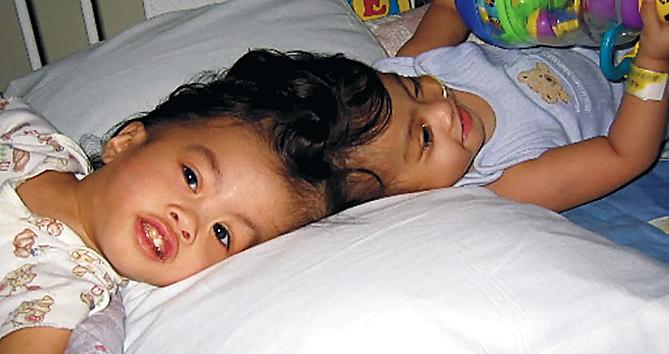Double challenges and rewards

I have been a neurosurgical operating room nurse at Montefiore Medical Center in the Bronx for 32 years. The work is not easy; it can be stressful, exhausting, but definitely is challenging and rewarding, as well. After many years, I thought I had seen it all, until the separation of the Aquirre craniopagus conjoined twins 10 years ago.
Craniopagus twins are the rarest of conjoined twins. Connected on their heads, this condition occurs in only one of approximately 2.5 million births. Only a handful survive and attempts to separate them often result in death or permanent handicaps for one or both.
Clarence and Carl
On September 10, 2003, Clarence and Carl Aguirre, a set of 16-month old craniopagus twins from the Philippines, came to New York with their mother for separation surgery at the Children’s Hospital at Montefiore. All services were provided free by Montefiore and other support facilities.
On the 10th anniversary (August 4, 2014 ) of the successful separation of the two boys, I recall with great honor and pride my participation in such a historic humanitarian and scientific endeavor. The stage separation, four operations over a 10- month period, was the first ever done in this state. It has also become an international model for craniopagus separations.
I looked back in awe at what we accomplished as a team, for only a dedicated team of nurses, doctors, nutritionists, physical therapists, speech therapists, social workers and chaplain could have made it possible. Not to be forgotten was the mother, an important member of this team. Montefiore and the Filipino communities, especially in NY, rallied around her.
The OR team had the daunting task of planning for nurse staffing needs, educating nurses about separating craniophagus twins, including the special pieces of equipment and products needed, preparing the surgical suites, surgical sites, positioning for surgery, draping of the surgical sites, traffic control in the OR, and public relations. Along the way, we had to harness our creativity in draping and positioning and in anticipating emergencies.
I have the pleasure of seeing the twins now twice a year, on their birthday on April 21 and on the August 4 anniversary , which their mother refers to as their “second birthday”. Carl and Clarence are now 12 years old. Clarence has become a very active boy. He speaks well and loves to sing. Carl has had a tougher time. He developed a seizure disorder and his ability to learn has been hampered by the seizure-control medications.
A humbling roll
I have shared my experience of this extraordinary medical undertaking with colleagues in nursing grand rounds, at open house for the hospital and as a keynote speaker for the International Society of Pediatric Neurosurgeons in Liverpool, UK. I co-authored an article, “Staged Separation of Craniopagus Conjoined Twins: A Multidisciplinary Approach,” published in the AORN Journal (Association of periOperative Registered Nurses).
Very few nurses have the opportunity to separate craniopagus twins. I am very fortunate to be one of them and am humbled by the role I played.